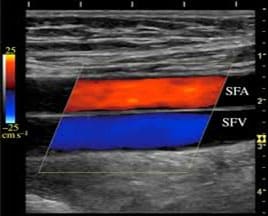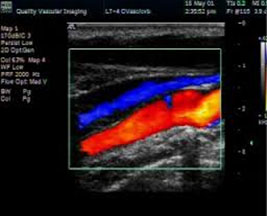Arterial doppler ultrasound
An arterial ultrasound is used to scan the arteries of the upper extremities (arms) as well as the lower extremities (legs). Ultrasound scanning is used to evaluate for stenosis, blockage, plaques, clots and other abnormalities that may be present throughout the arteries. Along with an ultrasound study, blood pressures are obtained from both ankles and arms (known as ankle brachial index) to show a ratio of the blood pressure traveling from lower to upper extremities. Patients with a history of peripheral arterial disease, hypertension, and smoking should have their arteries checked to evaluate the blood flow through the limbs and to prevent serious conditions that could result in the loss of blood flow to the body. Arterial Doppler Ultrasound uses sound waves to measure the direction of blood flow as well as strength.
Venous ultrasound
A venous ultrasound is used to scan the veins of the upper extremities (arms) as well as those of the lower extremities (legs) to evaluate and diagnose deep vein thrombosis (blood clots), blockage, peripheral vascular disease, stenosis, and more. A blood clot in the lower extremities can be a life threatening issue and should be diagnosed immediately if there is any suspension of one being present.
Patients with a previous history of deep vein thrombosis or blood clots should have their veins evaluated at different time intervals. Patients who are prescribed blood thinners to help diminish the thrombosis within the vein should have an ultrasound performed to detect if the clot has resolved or needs further treatment.
Venous Insufficiency Ultrasound is used to scan the lower extremity superficial veins and the deep veins and assess source and course of varicose veins. This specific test is most commonly done for patients who present with ulcer wounds, varicose veins and other signs of venous incompetence or insufficiency. A venous incompetence ultrasound helps map out the veins from the groin to the ankle. An ultrasound of the superficial veins, great saphenous vein, the short saphenous vein and the deep veins can shed light on the source of venous reflux, weakened venous valves, and identify the origin of varicose veins.
Performing leg vein anatomy and venous mapping of the lower extremities can help diagnose and improve overall circulations throughout the venous system and resolve unwanted varicose veins and superficial veins.
Benefits of performing a vascular ultrasound
The circulatory system plays an important role in supplying nutrition to the different areas of the body and important organs. A vascular ultrasound can easily and safely diagnose various abnormalities related to vascular structure and help in the treatment of various circulatory conditions such as venous ulcers, vascular ulcers, varicose veins and more.




